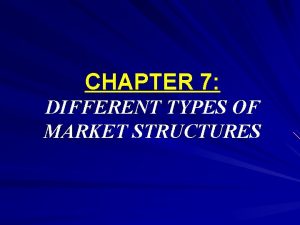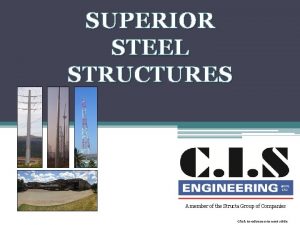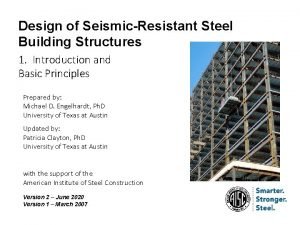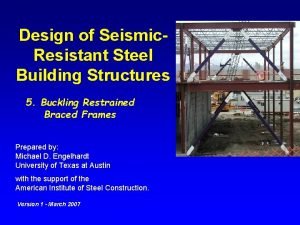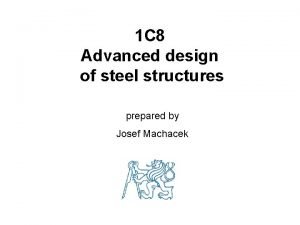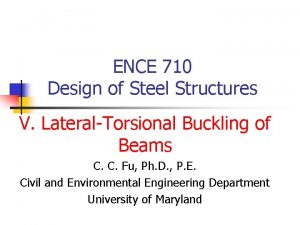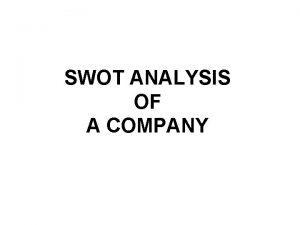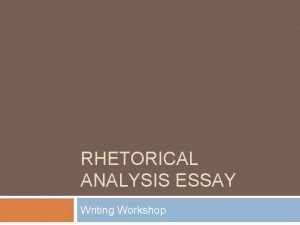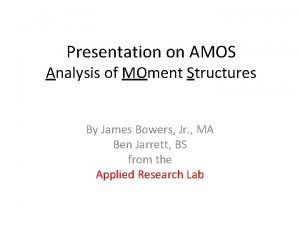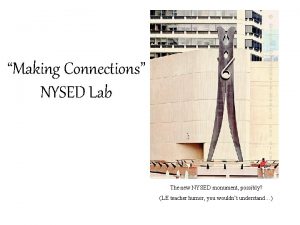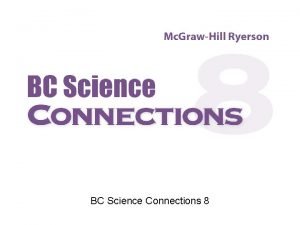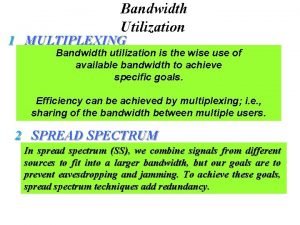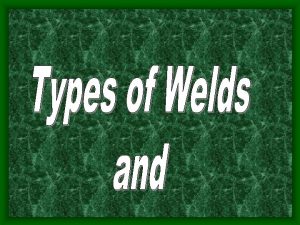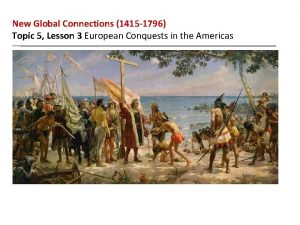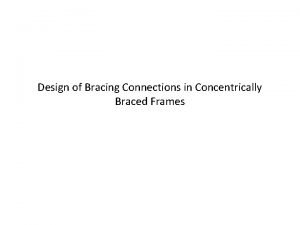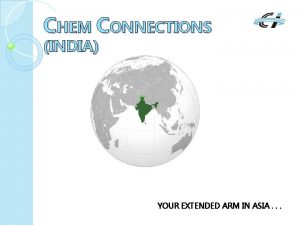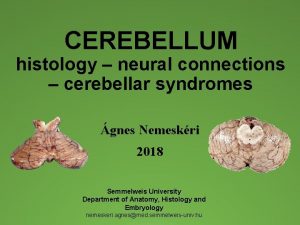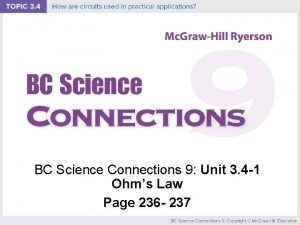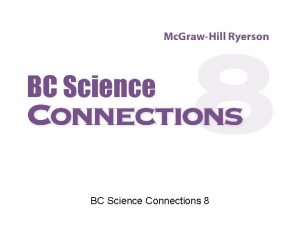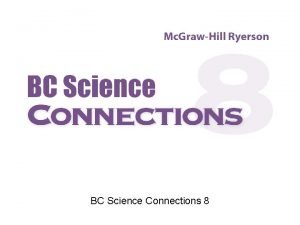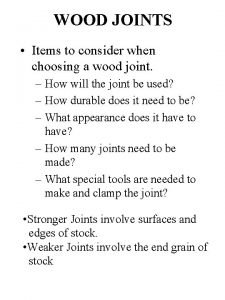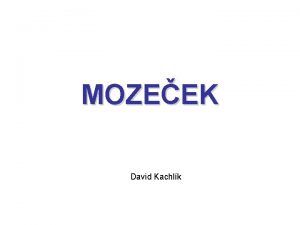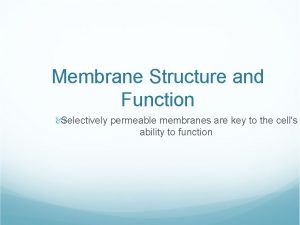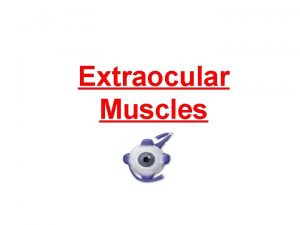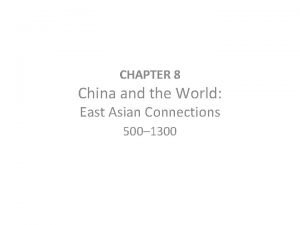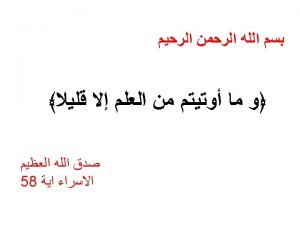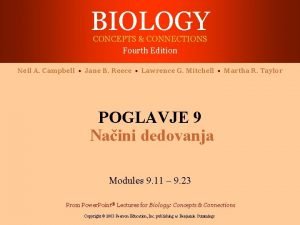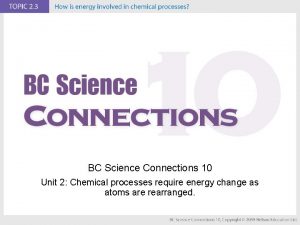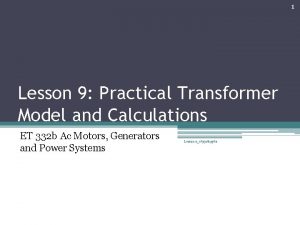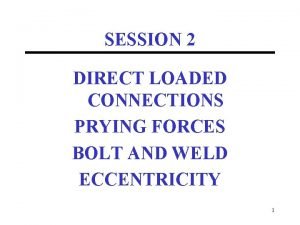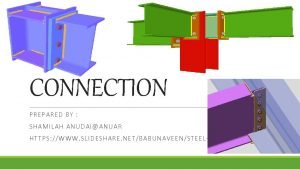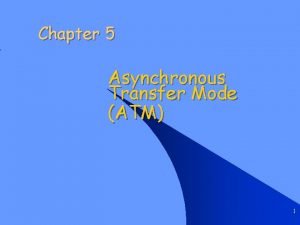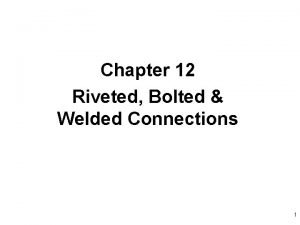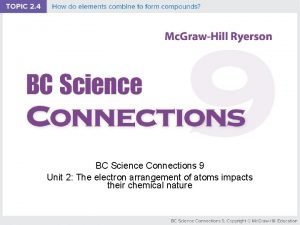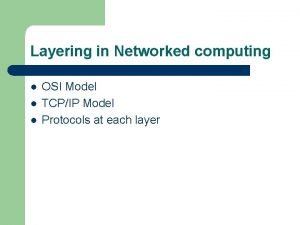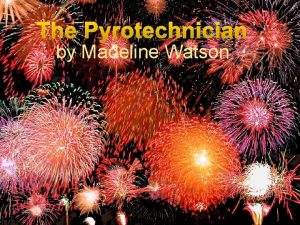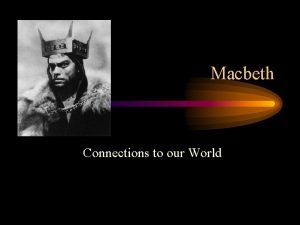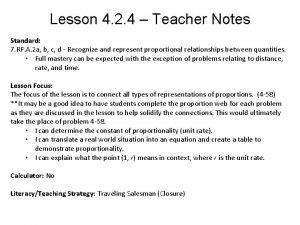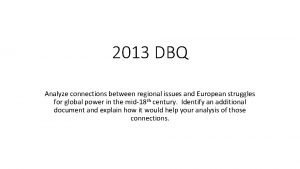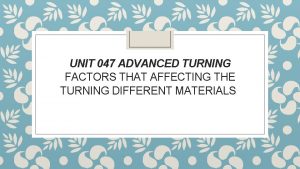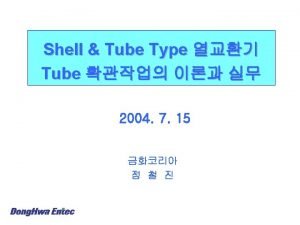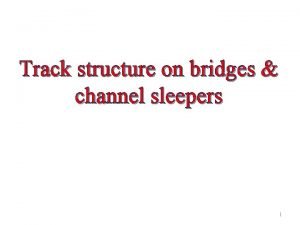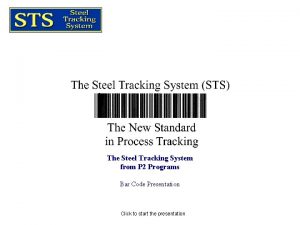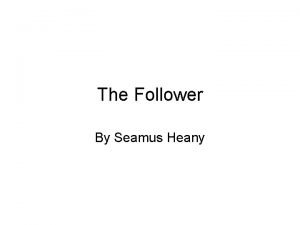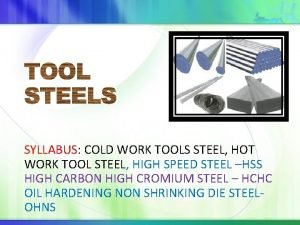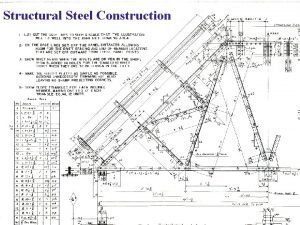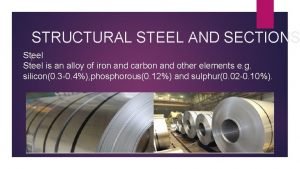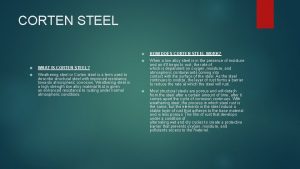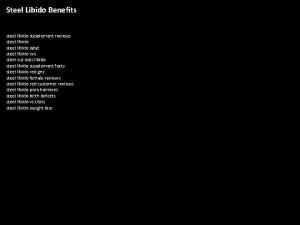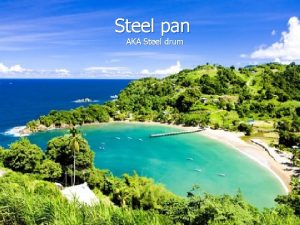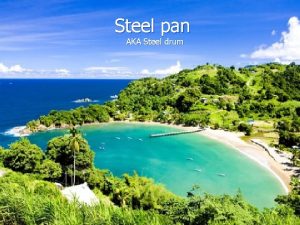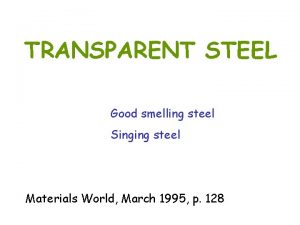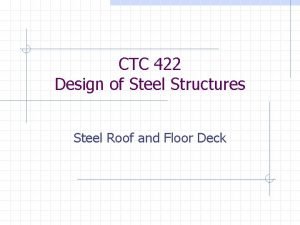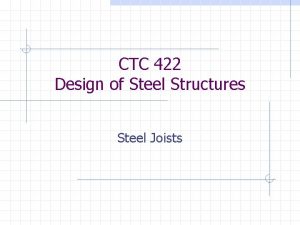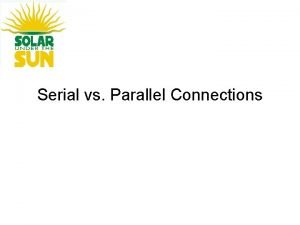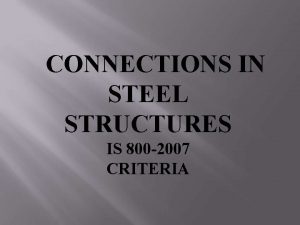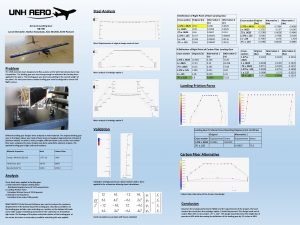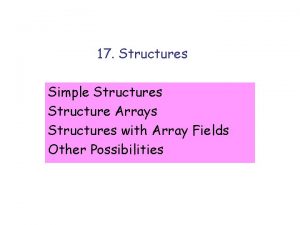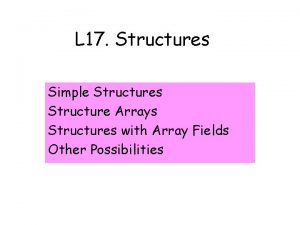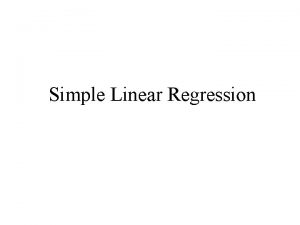1 Analysis of simple connections in steel structures



















































































































- Slides: 115

1 Analysis of simple connections in steel structures subjected to natural fire Academic year 2009 -2010

1. Introduction 2 Fire in a building cause deaths and destruction of goods (Department Store « Innovation » , 1967). Division of buildings in compartments Three types of criteria should be fulfilled : insulation, integrity and resistance.

1. Introduction 3 90’s : fire research focused on the single elements. Then, global behaviour of steel structures without focusing on the behaviour of connections because : a) Exposure of joints to fire is lower than for beams and columns. b) More material is concentrated in the joint zone Conclusion : A same level of fire protection for joints and structural elements was considered

1. Introduction 4 Cooling phase : key issue for the fire resistance of steel structures (WTC, Cardington, Coimbra tests, …)

1. Introduction 5 Origins of failures in connections during cooling Development of tensile forces due to axial restraints and plastic deformations Limited ductility of bolts and welds components when joint resistance is not sufficient Bolts and welds strengths under fire decreases faster than the carbon steel strength

1. Introduction 6 Previous work on steel connections (Heating) Behaviour of bolts and welds at elevated temperatures (Riaux, Kirby, Latham) Behaviour of bolted joints (Wainman, Universities of Manchester and Sheffield) Investigations about the influence of connections behaviour on the performance of beams under fire (University of Manchester)

1. Introduction 7 Previous work on steel connections (natural fire) 7 th Cardington test Investigations on rigid and semi-rigid connections under natural fire (University of Coimbra) The objective of the present work is to focus on the behaviour of simple steel connections (and of connected beams) under natural fire.

Overview of thesis 8 1. 2. 3. 4. 5. Introduction Distribution of temperature in joints Prediction of internal forces in steel joints under natural fire Experimental tests and models for the behaviour of connection components under heating/cooling Experimental tests and numerical investigations for the mechanical behaviour of steel connections under natural fire

9 Part 2 Temperature in joints of a steel structure during a natural fire Academic year 2009 -2010

2. Distribution of temperature 10 Time-temperature curve divided in four stages Analytical models, Zone models and Field models to predict the distribution of temperature of the compartment

2. Distribution of temperature 11 Prediction of temperature : steel members and joints Lumped Capacitance Method for steel members (EN 1993 -1 -2 and EN 1994 -1 -2) + joints (Annex D of EN 1993 -1 -2) Temperature profile of joints covered by a concrete slab (EN 1993 -1 -2)

2. Distribution of temperature 12 Assumptions of the Lumped Capacitance Method Uniform temperature in the zone considered Heat exchanges between the steel section and the concrete slab are not taken into account (adiabatic) Zone considered for joints not defined accurately

2. Distribution of temperature 13 Flange heated on 3 sides (ISO) Flange heated on 3 sides + slab Evolution of Temperature

2. Distribution of temperature 14 Flange heated on 3 sides (ISO) Flange heated on 3 sides + slab Evolution of Temperature

2. Distribution of temperature 15 Assumptions of the temperature profile for joints Adapted to ISO curve Ratios independent of time Geometry of the joint not considered in detail

2. Distribution of temperature 16 What we want ? Predict temperature at flanges levels accounting for the presence of the concrete slab Profile of interpolation for temperature between How ? flanges Adaptations to existing methods or new methods Validations against numerical simulations

2. Distribution of temperature 17 FE Model : SAFIR 2 D and 3 D IPE 180 to IPE 550 sections ISO and parametric fires Case n° Beam Column Plate 1 IPE 300 HEA 300 200*380*10 2 IPE 550 HEM 300 410*625*25

2. Distribution of temperature 18 2. 1 Level of the bottom flange – 2 D Beam section OK Lumped capacitance Method : (Am/V) of the flange Point of reference

2. Distribution of temperature 19 2. 2 Level of the bottom flange – 3 D Joint zone Lumped Capacitance Method : (Am/V)joint = (Am/V)beam/2 IPE 300 configuration Point of reference OK

2. Distribution of temperature 20 2. 3 Level of the top flange – 2 D Beam section Lumped Capacitance Method : (Am/V) of the flange (3 sides heated) Not OK IPE 300 beam Point of reference

2. Distribution of temperature 21 2. 3 Level of the top flange – 2 D Beam section Composite Section Method

2. Distribution of temperature 22 2. 3 Level of the top flange – 2 D Beam section Composite Section OK for heating phase Method Heatin g Heating + Cooling

2. Distribution of temperature 23 2. 3 Level of the top flange – 2 D Beam section Heat Exchange Method Lumped Capacitance Method T 1, T 2 : Temperatures of the top and bottom flanges x : Length of heat transfer (chosen equal to the root fillet)

2. Distribution of temperature 24 2. 3 Level of the top flange – 2 D Beam section Heat Exchange Method OK Graph n° 1 : IPE 300 beam – G = 1 – theating = 30 min Graph n° 2 : IPE 550 beam – G = 1 – theating = 30 min Graph n° 3 : IPE 550 beam – G = 1 – theating = 60 min

2. Distribution of temperature 25 2. 4 Level of the top flange – 3 D Joint zone Lumped Capacitance Method : (Am/V)joint = (Am/V)beam/2 Not OK (idem 2 D beam) Composite Section Method OK for heating phase (idem 2 D beam)

2. Distribution of temperature 26 2. 4 Level of the top flange – 3 D Joint zone Heat Exchange Method Lumped Capacitance Method T 1, T 2 : Temperatures of the top and bottom flanges

2. Distribution of temperature 27 2. 4 Level of the top flange – 3 D Joint zone Heat Exchange Graph n° 1 : Heating Method Beam section : IPE 300 OK Graph n° 2 : Heating + Cooling Beam section : IPE 300

2. Distribution of temperature 28 Interpolation between levels of top and bottom flanges A. IPE B. Beam Joint ––IPE Temperature profile suggested (beam + joint) 300 n° 1 : ISO Graph (Heating) Graph n° 2 : Param (Cooling) Reference Lines 2 -D 3 -D

2. Distribution of temperature 29 Summary Level of the bottom flange (2 D and 3 D) Lumped Capacitance Method. OK Level of the top flange (2 D and 3 D) Not OK Lumped Capacitance Method Composite Section Method Heat Exchange Method OK for heating phase OK Limited field of application

30 Part 3 Internal forces in an axially and rotationally restrained beams subjected to natural fire V M N Academic year 2009 -2010

3. Prediction of internal forces 31 A In real cases : superposition of axial forces and bending moments due to non-uniform elevation of

3. Prediction of internal forces 32 Vertical deflections induce beam shortening or axial forces The combination of axial forces and vertical deflections influences the distribution of bending Equilibrium must be stated in the deformed moments configuration Yin (2005)

3. Prediction of internal forces 33 All terms are function of the mid-span deflection dm, max Deflection profile : Pinned : Rigid : Semi-rigid : Axial force : where :

3. Prediction of internal forces 34 All terms are function of the mid-span deflection dm, max Mid-span bending moment : Support bending moment : Inelastic interaction :

3. Prediction of internal forces 35 All terms are function of the mid-span deflection dm, max Adaptations for non-uniform profiles of temperature : Pinned : Rigid : Semi-rigid : where :

3. Prediction of internal forces 36 Modification n° 1 : Consideration of the elliptic branch for evaluation of F T F Fp Fpropor l DLm, propor DLm, pl (fp , fy , E) (Fpropor , Fpl , K’A) DLm

3. Prediction of internal forces 37 Modification n° 2 : Consideration of the elliptic branch for evaluation of M T and MR based on the development of a method to predict the (M, c) diagram of a beam section under axial force and a non-uniform distribution of temperature.

3. Prediction of internal forces 38 Modification n° 2 : Comparison with FE model (SAFIR) with fibre elements

3. Prediction of internal forces 39 Modification n° 3 : Expression of thermally-induced bending moment Mt Equation of compatibility : + Limitation of the bending moment to Mpl, beam and Mpl, joint

3. Prediction of internal forces 40 Modification n° 4 : Extensional stiffness of the beam (2 nd order effects) d FT, 1 = 1 L Pinned connections Rigid connections

3. Prediction of internal forces 41 Modification n° 5 : Coefficient of interpolation between deflection profiles with pinned and rigid connections evaluated by stating the equilibrium between the bending moments at the beam extremity and the joint. L = 5 m IPE 300 beam w = 10 k. N/m KR = 10. 000 k. N. m/rad Equilibrium

3. Prediction of internal forces 42 Validation of a model built in SAFIR by simulating tests performed at the University of Manchester (Liu, 1999) « Rugby goal post » sub. Flush End 2 tests on simplystructure plate supported beams 3 tests on sub-structures Web with web-cleats Cleats connections 10 tests on substructures with flush endplate connections

3. Prediction of internal forces 43 Validation of the model built in SAFIR by simulating tests performed at the University of Manchester (Liu, 1999) Mechanical Analysis : Simply-supported beams Tcritical if T is uniform

3. Prediction of internal forces 44 Validation of the model built in SAFIR by simulating tests performed at the University of Manchester (Liu, 1999) Mechanical Analysis : Sub-structures with flush end-plate connections Axial restraint s Rotationa l restraints Identical horizontal displacement Identical rotation Symmetr y condition s

3. Prediction of internal forces 45 Validation of the model built in SAFIR by simulating tests performed at the University of Manchester (Liu, 1999) Mechanical Analysis : Sub-structures with flush end-plate connections KA = 8 k. N/mm Mid-span deflections : Force : Axial Hogging Bending Moment :

3. Prediction of internal forces 46 Validation of the Modified Method under heating 1. Simply-supported beam - Non-uniform distribution of T° Deflections Axial Force Bending Moments

3. Prediction of internal forces 47 Validation of the Modified Method under heating 2. Bilinear rotational restraints - Non-uniform distribution of Bending Moments T° Deflections Axial Force Mid-span Support

3. Prediction of internal forces 48 Analysis of the influence of the proposed modifications Modifications n° 1 & 2 : Elliptic branch of the stressstrain diagram of carbon steel for (F, DLm) and (M, cm) diagrams 6 meter-long IPE 300 beam (S 275) Distribution of T° : Ratios 0. 8 – 1. 2 KR = 3000 k. N. m/rad (elastic) w = 0. 5 – K = 3% Degree of accuracy enhanced Better convergence at the transition « bending -

3. Prediction of internal forces 49 Analysis of the influence of the proposed modifications Modification n° 3 : Expression of thermallyinduced bending moment Mt Aimed at extending the field of application of the Modified Method !

3. Prediction of internal forces 50 Analysis of the influence of the proposed modifications Modification n° 4 : Extensional stiffness KA of the beam accounting for 2 nd order effects Results obtained from the Modified Method before and after Modification n° 4 are superposed Deformability of the beam << Deformability of the spring The extensional stiffness KA of the beam is modified for large deflections where FT = FT, pl

3. Prediction of internal forces 51 Analysis of the influence of the proposed modifications Modification n° 5 : Coefficient of interpolation cf used for deflection profile of the beam 6 meter-long IPE 300 beam (S 275) Distribution of T° : Ratios 0. 8 – 1. 2 KR = 3000 k. N. m/rad (elastic) w = 0. 5 – K = 3% No influence on deflections and axial forces Prediction of bending moments significantly improved

3. Prediction of internal forces 52 Extension to the cooling phase (Li, 2006) Based on the 2 principles proposed for material law of carbon steel when cooling (Franssen, 1990) Validated only for the prediction of deflections and axial forces Plastic strains constant during the variation of T° Length of the elastic branch constant when unloading

3. Prediction of internal forces 53 Adaptation of the Modified Method to the cooling phase The resolution of the General Equation is made at the Mid-spanpoint) Bending Moment end of the heating phase (reference The (FT, DLm) and (M, cm) diagrams are adapted for the cooling phase The General Equation is solved at any instant of the cooling phase

3. Prediction of internal forces 54 Adaptation of the General Method to the cooling phase 1. Simply-supported beam - Non-uniform distribution of T° 6 meter-long IPE 300 beam (S 275) Tref : 600°C – 650°C – 700°C w = 0. 3 – K = 3% Deflections Axial Force Mid-span Bending Moment

3. Prediction of internal forces 55 Adaptation of the General Method to the cooling 2. phase Bilinear rotational restraints - Uniform distribution of T° Mid-span 6 meter-long IPE 300 beam (S 275) Tref : 700°C – 700°C w = 0. 5 – K = 10% Deflections Axial Force Bending Moments Support

3. Prediction of internal forces 56 Summary (1 st) Simplified method developed by Yin and Li has been modified in order to improve the prediction of bending moments in restrained beams (heating + cooling) It has also been possible to limit the bending moment at the beam extremities in order to account for joint resistance A numerical model built in SAFIR software has been used as reference for the validation of these modifications For each modification, the enhancement of accuracy

3. Prediction of internal forces 57 Summary (2 nd) Good predictions of internal forces and deflections Field of application remains limited to bilinear and constant rotational restraints in spite of several modifications making the algorithm more complex Including the real behaviour of connections in this Method seems difficult (contact between beam and column flanges, M-N interaction) and the use of simple FE models is recommended for the analysis of the behaviour of simple steel connections

58 Part 4 Experimental tests and models for bolts and welds under heating and subsequent cooling Academic year 2009 -2010

59 4. Tests and models for bolts/welds Review of previous work on bolts and welds Riaux (1980) : Tensile and shear tests on Grade 8. 8 bolts after heating Kirby (1995) : Tensile and shear tests on Grade 8. 8 bolts after heating EN 1993 -12 Gonzalez (2008) : Tensile tests on Grade 10. 9 bolts during heating and after cooling (residual) Latham (1993) : Tests on fillet and butt welds

60 4. Tests and models for bolts/welds Bolts Objective Strength Reduction Factor Heating phase : OK Residual : Few data Cooling phase : No data Welds Temperatur e Heating phase : OK Residual : No data Cooling phase : No data

61 4. Tests and models for bolts/welds Test methodology Room temperature tests Steady-state tests at elevated temperatures (a) Steady-state tests performed at various Tf after temperature has reached Tu (b)

4. Tests and models for bolts/welds 62 Tu Schedule of tests performed on Grade 8. 8 bolts Tensile Shear Heating tests Cooling Heating Cooling tests = T [°C] n. tests T =T f 20 200 400 600 800 2 1 1 u 400 600 800 900 f 200 100 20 400 300 200 100 20 600 400 300 200 100 20 20 2 1 1 1 1 1 2 1 1 1 u [°C] 20 200 400 600 800 f n. tests 2 1 1 Tu [°C] 600 800 900 Tf [°C] 400 300 200 100 20 600 400 300 200 100 20 20 n. tests 1 1 2 1 1 1

63 4. Tests and models for bolts/welds Schedule of tests performed on welds Heating Cooling Tu = Tf [°C] 20 200 n. tests 1 1 400 600 1 1 800 1 Tu [°C] 400 600 800 900 Tf [°C] 200 100 n. tests 1 1 20 400 1 - 200 - 20 600 1 1 400 200 1 1 20 1 400 1 20 1

64 4. Tests and models for bolts/welds Experimental values of reduction factor for bolt strength kb Tensile tests Shear tests Heating Tests Tf (°C)

65 4. Tests and models for bolts/welds Model for bolt strength fub during cooling EN 1993 -1 -2 Tf : Failure temperature Tu : Upper temperature (at the end of heating phase)

66 4. Tests and models for bolts/welds Force-displacement model for bolts in tension F Fub, q Fpb, q Ftb, q Sb, q dpb, q dyb, q dtb, q dub, q d

67 4. Tests and models for bolts/welds Force-displacement model for bolts in tension Heating (Tu = Tf) Large displacements

68 4. Tests and models for bolts/welds Force-displacement model for bolts in tension Residual (Tf = 20°C) Significant loss of strength Large displacemen ts Cooling (Tf = 400°C)

4. Tests and models for bolts/welds 69 Force-displacement model for bolts in R shear Rub, q Sst, q Rb, q Sb, q dub, q dfb, q d

70 4. Tests and models for bolts/welds Force-displacement model for bolts in shear Cooling (Tf = 20°C) Significant loss of strength Cooling (Tf = 200°C)

71 4. Tests and models for bolts/welds Experimental values of reduction factor for weld strength kw No Cooling Heating + Cooling

72 4. Tests and models for bolts/welds Analytical values of reduction factor for weld strength EN kw 1993 -1 -2 Tf : Failure temperature Tu : Upper temperature (at the end of heating phase)

73 4. Tests and models for bolts/welds Summary The influence of heating-cooling cycles on bolts and welds strength is significant (knr, b, min = 0. 6 ; knr, w, min = 0. 8) Ductility of bolts is increased when submitted to a heating-cooling cycle where Tu (at the end of the heating phase) exceeds 500°C. Material laws, including a descending branch, have been proposed for bolts in tension and bolts in shear. They can be applied to component-based models aimed at predicting the behaviour of steel

74 Part 5 Global behaviour of simple connections under natural fire Pinned Academic year 2009 -2010

75 5. Tests and models of connections State-of-the-art Models for semi-rigid joints : curve fit models, mechanical models, FE models and macroelements Mechanical Curve-fit models Solid Macro-elements models Ang (1984) models Cerfontaine (2004) Block (2006)

76 5. Tests and models of connections State-of-the-art : Simple connections under fire conditions Isothermal tests on isolated connections performed at the University of Sheffield (Yu, 2009) + mechanical models One of the natural fire tests performed at University of Coimbra (Santiago, 2008) Type of connection (FP, WC and HP) Temperature (20°C – 450°C – 550°C – 650°C) Angle of the loading (35° – 55°) Number, diameter and grade of bolts

77 5. Tests and models of connections Description of the tests performed recently by Efectis Test n° 1 (Metz) Heated gradually until Test stopped at Tfurnace = failure 840°C (Tbottom flange = 800°C) Flush end-plate Beam deflection > 220 mm connections No of bolts 5. 5 failure meter-long IPE 300 10 mm-thick plate beam Thermally-protected HEA 220 column K = 1% L. R. = 0. 3 (theoretically) IPE 300 beam

78 5. Tests and models of connections Description of the tests performed recently by Efectis Test n° 2 (Metz) Heated gradually until Beam = 58 mm 700°C deflection before natural (constant cooling during cooling) No failure of bolts Flush end-plate connections 10 mm-thick plate 5. 5 meter-long IPE 300 beam Thermally-protected HEA 220 column K = 1% IPE 300 beam

79 5. Tests and models of connections Description of the tests performed recently by Efectis Test n° 3 (Delft) Heated gradually until d = 200 mm before natural cooling Temperature reached 650°C in connections the beam and Fin plate 600°C near the. IPE joint 300 4. 4 meter-long beam Failure of bolts after 127 minutes Thermally-protected HEB 300 column K = 6. 6% L. R. = 0. 3 (fy = 345 MPa)

80 5. Tests and models of connections Description of the tests performed recently by Efectis Test n° 4 (Delft) Heated gradually until d = 200 mm before natural cooling Temperature reached 670°Ccleats in theconnections beam and Web 600°C near the. IPE joint 300 4. 4 meter-long beam No failure of bolts Thermally-protected HEB 300 column K = 6. 6% L. R. = 0. 3 (fy = 345 MPa)

81 5. Tests and models of connections Numerical model for connections : Bilinear Fibres Model The action of joints is represented by beam elements including one fibre per bolt or compressive row Cross-section of the beam element

82 5. Tests and models of connections Numerical model for connections : Bilinear Fibres Model Fin plate Web cleats Header Plate Flush end-plate

83 5. Tests and models of connections Numerical model for connections : Bilinear Fibres Model Translated BILIN_TENS Symmetric to BILIN_COM P! BILIN_COM P BILIN_BOLT S BILIN_COMP BILIN_ASYM

84 5. Tests and models of connections Numerical model for connections : Bilinear Fibres Model Failure criteria 1. Classes of ductility Resistance Class C Class A Class B Plastic resistance of weakest ductile component Ultimate resistance of weakest ductile component Resistance of weakest brittle component Temperature

85 5. Tests and models of connections Numerical model for connections : Bilinear Fibres Model Failure criteria Resistanc 2. Criteria e Criterion n° 1 : One fibre representing the action of a class C bolt row is yielded or Criterion n° 2 : All the fibres representing the action of bolt rows are yielded and at least one bolt row is class B Class C Class A Class B Temperature Plastic resistance of weakest ductile component Ultimate resistance of weakest ductile component Resistance of weakest brittle component

86 5. Tests and models of connections Numerical model for connections : Bilinear Fibres Model Test n° 1 (Metz) Restraining system modelled by one element (elastic spring) fy = 355 MPa. fub : 956 Mpa (tests at room T°) - Experimentally, failure after 70 min (Tfurnace = 797°C) - Good correlation

87 5. Tests and models of connections Numerical model for connections : Bilinear Fibres Model Test n° 2 (Metz) No failure

88 5. Tests and models of connections Numerical model for connections : Bilinear Fibres Model Test n° 3 (Delft) : Fin plate connections Criterion n° 2 reached after 119 min. – Experimentally : failure after 127 min.

89 5. Tests and models of connections Numerical model for connections : Bilinear Fibres Model Test n° 4 (Delft) : Web cleats connections The weakest components are ductile – No failure

90 5. Tests and models of connections Numerical model for connections : Bilinear Fibres Model Parametric Analyses Parameters investigated : Type of connection : Fin plate, Web cleats, Header plate Load ratio : 0. 3, 0. 5 and 0. 7 Duration of the fire : Short (ISO) or Long (60 min) Beam span : 6 m (IPE 300) or 12 m (IPE 550)

91 5. Tests and models of connections Numerical model for connections : Bilinear Fibres Model Parametric Analyses : Fin plate connections Bilinear Fibres Model Abaqus Model FEM model - Source : Corus Ltd

92 5. Tests and models of connections Numerical model for connections : Bilinear Fibres Model Parametric Analyses : Web cleats connections Bilinear Fibres Model ANSYS Model FEM model - Source : d >> L/20 CTICM

93 5. Tests and models of connections Numerical model for connections : Bilinear Fibres Model Parametric Analyses : Header plate connections Bilinear Fibres Model Abaqus Model FEM model - Source : Corus Ltd

94 5. Tests and models of connections Parametric Analyses : Conclusions Influence of ductility classes (design + Tmax) : ratio « resistance of bolts in shear/resistance of beam web in bearing » higher for web cleats than fin plates. Bolts situated close to the top flange increase the fire resistance but this effect is counter-balanced by failures during cooling phase Cases with large deflections (d > L/20) at the end of the heating phase should be rejected

95 5. Tests and models of connections Numerical model for connections : Bilinear Fibres Model Additional cases : Fin plate connections K = 5% K = 12%

96 5. Tests and models of connections Proposed design procedure for simple connections 1. Heating phase Evolution of temperature profiles (cfr. part 2) Multiplication of w by 1. 1 (restraints) Evaluation of the time of fire resistance t 1 (following EN) Evaluation of kcooling Verification that kcooling*t 1 > theating

97 5. Tests and models of connections Proposed design procedure for simple connections 2. Cooling phase Recommendation n° 2 n° 1 : < T ofatthe T resistance thebrittle end ofcomponents heating phase is higher bottom flange lim or w >the than wlimplastic resistance of the weakest ductile component (accounting for ) multiplied 1. 2 or The resistance of the is nr Finkbrittle plate : components wlim =by 0. 35 higher NO CLASS than the C ultimate resistance of the weakest Web cleats : wlim = 0. 25 ductile component (accounting for knr) multiplied by 1. 2 NO CLASS Header plate : wlim = B 0. 45

98 5. Tests and models of connections Proposed design procedure for simple connections 3. Summary CLASS B A during Inacceptable C cooling : w Acceptabl e Inacceptable Heating wlim Inacceptable Cooling Acceptabl e theating t(Tlim)

99 5. Tests and models of connections Proposed design procedure for simple connections Fin-plate K = 3% connections K = 10%

100 5. Tests and models of connections Numerical model for connections : Nonlinear Fibres Model General Material Law On the contrary of Bilinear F. M. , the Nonlinear F. M. allows an automatic detection of connection failures !

101 5. Tests and models of connections Experimental tests performed at Sheffield (2009)

102 5. Tests and models of connections Numerical simulation of tests realised at Sheffield (2009) Force-displacement diagrams of bolt rows Heating Phase Cooling Phase

103 5. Tests and models of connections Numerical simulation of tests realised at Sheffield (2009) Force-rotation diagrams : Tests n° 1 to 4 (a = 55°)

104 5. Tests and models of connections Numerical simulation of tests realised at Sheffield (2009) Force-rotation diagrams : Tests n° 5 to 8 (a = 35°)

105 5. Tests and models of connections Numerical simulation of tests realised at Delft (Test n° 3)

106 5. Tests and models of connections Case Study Joint represented by Nonlinear Fibres Model

107 5. Tests and models of connections Summary Component-based models and material laws defined for the modelling of simple connections under natural fire Bilinear Fibres Models and Nonlinear Fibres Models validated against experimental tests and other numerical simulations (solid models). Differences by the degree of difficulty, the field of application and the ability to predict connection failures Predominent influence of ductility on the

108 Part 6 General conclusions Academic year 2009 -2010

6. General Conclusions 109 Detailed list of personal contributions (1/3) Proposal of new simple methods for the prediction of temperature in 2 D-beam sections and 3 D-joint zones covered by a concrete slab and calibration on numerical results Validation against experimental tests performed at the University of Manchester of a model built in SAFIR for the prediction of internal forces in axially- and rotationally-restrained beams under fire conditions Adaptations to the simplified method developed by Yin and Li for predicting bending moments profiles in axially- and rotationallyrestrained beams during heating and cooling phases of a fire and extension to joints with a bilinear moment-rotation diagram Treatment of results of tests performed on bolts and welds under

6. General Conclusions 110 Detailed list of personal contributions (2/3) Development of analytical models for bolts (tension or shear) and welds during the heating and cooling phases of a fire Definition of two models and material laws for modelling the action of simple steel connections under natural fire conditions Definition of failure criteria for connections modelled by Bilinear Fibres Models and validations against experimental tests and numerical results obtained with more complex models Realisation of parametric analyses using the Bilinear Fibres Models for fin plate, double web cleats and header plate connections and definition of design procedures to avoid connection failures

6. General Conclusions 111 Detailed list of personal contributions (3/3) Development of Nonlinear Fibres Models for fin plate connections and validation against experimental results of isothermal tests performed on isolated joints (Sheffield) and a fire test performed on a sub-structure (Delft) Application of the Nonlinear Fibres Models to a large-scale steel structure with fin plate connections

6. General conclusions 112 General Conclusions (1/2) By use of quite simple methods that does not require FE models, possibility to predict distribution of temperature in beams and joints covered by a concrete slab The use of simplified methods for predicting internal forces in joints under natural fire is limited to cases where the behaviour of joints is bilinear and constant The influence of heating-cooling cycles on the resistance and the ductility of bolts and welds should be considered (knr, b, min = 0. 6 ; knr, w, min = 0. 8) force-

6. General conclusions 113 General Conclusions (2/2) The action of simple connections in steel structures under natural fire may be represented by fibre models, able to predict failures The ductility of connections has a major influence on the occurrence of connection failures classes of ductility

6. General Conclusions 114 Perspective s Validation of the Heat Exchange Method against experimental results (beam-slab contact) + protected members Analysis of the reversibility of deformations in carbon steel elements subjected to a heating-cooling cycle Integration of group effects and instability phenomena into numerical models for connections Definition of an adimensional fibre element for representing the action of joints following the Component Method Extension of this work to composite joints (tests available, models adapted). Attention should be paid to the concept of collaborating width)

115 Thank you for your attention !
 Structural steel connection calculations calculations
Structural steel connection calculations calculations Pantene conditioners
Pantene conditioners Superior steel structures
Superior steel structures Steel gable roof truss
Steel gable roof truss Site class seismic design category
Site class seismic design category Design of seismic-resistant steel building structures
Design of seismic-resistant steel building structures Advanced design of steel structures notes
Advanced design of steel structures notes Mode of failure in tension member
Mode of failure in tension member Steel structures
Steel structures Biology homology
Biology homology Swot tata motors
Swot tata motors Kennedy steel speech rhetorical analysis
Kennedy steel speech rhetorical analysis Present simple to have
Present simple to have Simple past simple present simple future
Simple past simple present simple future Present simple present continuous past simple future simple
Present simple present continuous past simple future simple Present simple present continuous past simple future simple
Present simple present continuous past simple future simple Future simple in the past
Future simple in the past Present simple, past simple, future simple
Present simple, past simple, future simple Tense chart for class 2
Tense chart for class 2 Definition simple present
Definition simple present Future simple present simple
Future simple present simple Maori sentences
Maori sentences Approximate method of structural analysis
Approximate method of structural analysis Analysis of moment structure
Analysis of moment structure Formal risk analysis structures in iot
Formal risk analysis structures in iot Cdci binghamton
Cdci binghamton Making connections task cards
Making connections task cards Forced connections examples
Forced connections examples Making connections lab report
Making connections lab report Text to world connection examples
Text to world connection examples Text to self examples
Text to self examples Balanced wye-wye connection
Balanced wye-wye connection Working connections child care
Working connections child care Bc science connections 8
Bc science connections 8 Four 1 kbps connections are multiplexed together
Four 1 kbps connections are multiplexed together Ynhs yakima
Ynhs yakima Architecture and construction career cluster definition
Architecture and construction career cluster definition Learning connections inventory
Learning connections inventory Different types of welded connections
Different types of welded connections Sky high medford
Sky high medford New global connections
New global connections Lesson 1 europeans explore overseas
Lesson 1 europeans explore overseas New connections academy palatine
New connections academy palatine Native connections housing
Native connections housing Executive connections
Executive connections Essential connections
Essential connections Bracing connections
Bracing connections Chem connections india
Chem connections india Chapter 22 traditions and encounters
Chapter 22 traditions and encounters Neural connections of cerebellum
Neural connections of cerebellum Career life connections lesson plans
Career life connections lesson plans Biology
Biology Bc science connections 9
Bc science connections 9 Bc science connections 8 textbook pdf
Bc science connections 8 textbook pdf Bc science connections 8
Bc science connections 8 Wood connections types
Wood connections types Tractus corticopontocerebellaris
Tractus corticopontocerebellaris Missed connections arlington va
Missed connections arlington va Intercellular connections
Intercellular connections Likes dislikes patterns and puzzles grid
Likes dislikes patterns and puzzles grid Web of knowledge connections
Web of knowledge connections Nerve supply to superior oblique
Nerve supply to superior oblique Connective tissue
Connective tissue Type file
Type file Chapter 8 china and the world east asian connections
Chapter 8 china and the world east asian connections Chapter 8 china and the world east asian connections
Chapter 8 china and the world east asian connections Intercellular connections
Intercellular connections Intercellular connections
Intercellular connections Chapter 23 transoceanic encounters and global connections
Chapter 23 transoceanic encounters and global connections Chapter 22 transoceanic encounters and global connections
Chapter 22 transoceanic encounters and global connections Chapter 22 transoceanic encounters and global connections
Chapter 22 transoceanic encounters and global connections Intercellular connections
Intercellular connections Kariogram človeka
Kariogram človeka Bc science connections 10
Bc science connections 10 Building customer connections
Building customer connections Practical transformer winding
Practical transformer winding Youth connections scale
Youth connections scale Prying forces in bolted connections
Prying forces in bolted connections Unite connections
Unite connections Making connections images
Making connections images Text to self clipart
Text to self clipart Fundamentals of nursing care concepts connections & skills
Fundamentals of nursing care concepts connections & skills Welded connections ppt
Welded connections ppt Asynchronous transfer mode architecture
Asynchronous transfer mode architecture Slidetodoc
Slidetodoc Career connections answer key
Career connections answer key Bc science connections 9 online
Bc science connections 9 online Watson career and alumni connections
Watson career and alumni connections Gsa connections ii
Gsa connections ii Connections ii contract information
Connections ii contract information North link connections mobility project
North link connections mobility project End connections
End connections Global connections definition
Global connections definition Housing connections application
Housing connections application Vocabulary connections
Vocabulary connections Web of connections
Web of connections Pyrotechnician job description
Pyrotechnician job description Southern gas networks new connections
Southern gas networks new connections Livia soprano evil
Livia soprano evil Proportional web
Proportional web Career life connections capstone project examples
Career life connections capstone project examples Making connections analyzing presidential decisions
Making connections analyzing presidential decisions Chapter 22 transoceanic encounters and global connections
Chapter 22 transoceanic encounters and global connections Loving connections
Loving connections Bold connections
Bold connections Analyze connections between regional issues
Analyze connections between regional issues Louder sound wave
Louder sound wave Steel stronger than iron
Steel stronger than iron P number material
P number material Rdso steel channel sleeper drawing
Rdso steel channel sleeper drawing Metal tracking system
Metal tracking system His shoulders globed like a full sail strung
His shoulders globed like a full sail strung A metallic tape is made of
A metallic tape is made of Hchc steel
Hchc steel Standard structural steel shapes
Standard structural steel shapes Compound fan truss
Compound fan truss

